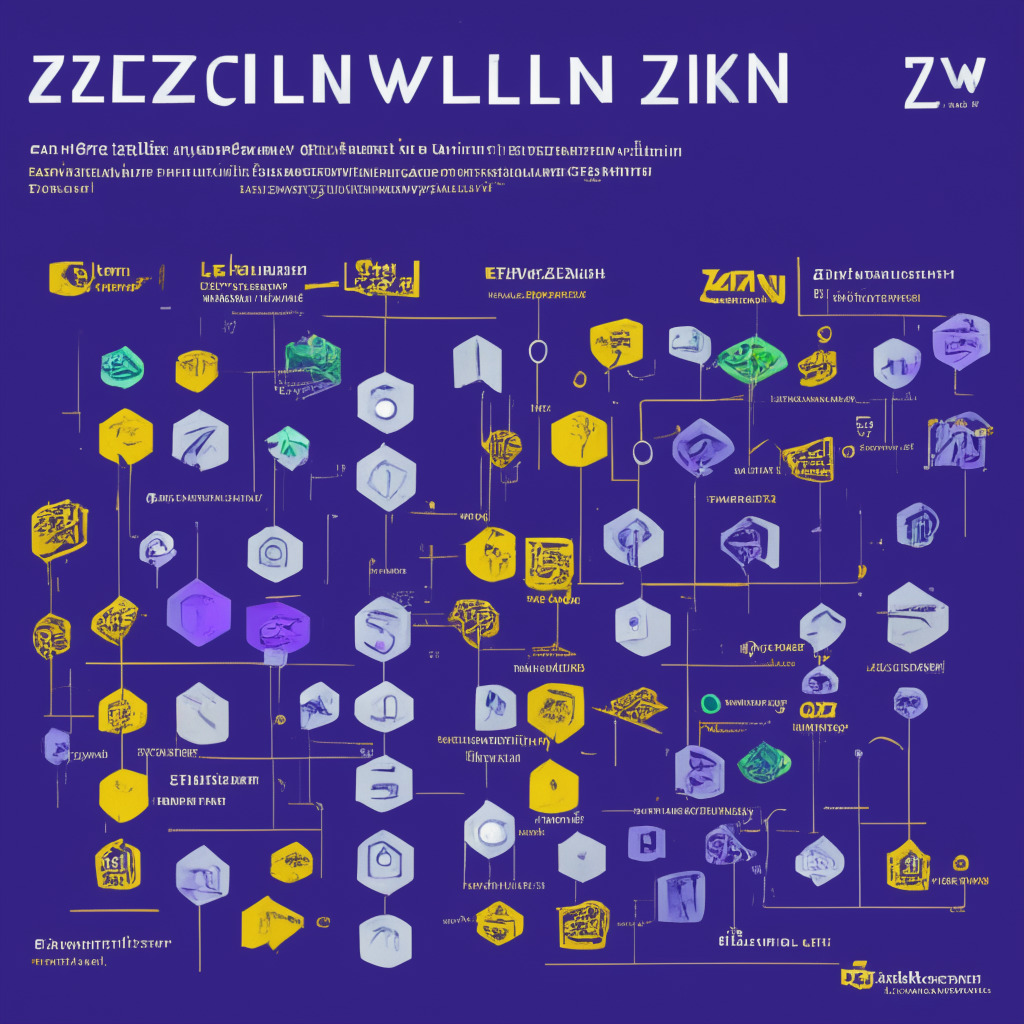The development of a standardized Ethereum staking rate benchmark, representing daily, annualized mean of on-chain rewards, could impact the cryptocurrency landscape. This rate could unlock the next generation of financial products and serve as a building block for Ethereum’s monetary policy, providing reference rate utility for market participants, and enabling risk transfer tools like swaps and futures.
Search Results for: Proof of Stake
Leased Proof-of-Stake: Game-Changer or Just Another Player in Blockchain Technology?
“Blockchain technology introduces Leased Proof-of-Stake (LPoS), an innovative mechanism aimed at overcoming crypto mining complications. LPoS allows tokenholders to lease their tokens to validator nodes, improving their chance at generating new blocks and sharing transaction fees. While offering benefits such as decentralization and fixed tokens, LPoS also maintains control by restricting trade or transfer of leased tokens.”
Watching Ethereum’s Unfold: ETF Applications, Market Manipulation, and the Shift to Proof-of-Stake
“Investment giants, Invesco and Galaxy Digital, are reportedly seeking regulatory approval for their spot Ethereum ETF. This follows prior similar requests like ARK 21Shares and VanEck. The introduction of Ether futures offers traditional investors access to crypto-assets and risk diversification, despite potential market manipulations and challenges in the regulatory approval process.”
Ethereum’s Bumpy Journey: From Proof-of-Work to Proof-of-Stake and Beyond
A pivotal upgrade known as the Merge transitioned Ethereum from a proof-of-work (PoW) consensus mechanism to a proof-of-stake (PoS), causing a net supply decrease of 299,922.50 ether. The PoS mechanism needs users to hold ether to validate transactions and earn rewards. This eliminated much miner supply and made Ethereum more eco-friendly. However, despite these changes, ether’s market values have stagnated.
Ethereum’s Proof-of-Stake Transition: A Year in Review and a Look into the Future
“Ethereum transitioned to the proof-of-stake system reducing power consumption by over 99% and making the network economically deflationary. However, anticipated price surge due to deflationary pressure hasn’t materialized swiftly. Liquid staking providers control significant amounts of staked Ether, raising potential centralization concerns.”
Ethereum’s Switch to Proof-of-Stake: A Sustainable Step or a Misdirected Move?
“Ethereum’s shift from proof-of-work to proof-of-stake, known as the “Merge”, is viewed differently by stakeholders. While the move reduced Ethereum’s energy demands and is hailed as a ‘green’ shift, it overlooks the ongoing significant energy consumption from graphics processing units previously used in mining. Moreover, perspectives on security and profitability under the new system remain contentious.”
Blockchain’s Leap to Outer Space: NASA’s Moon Mission and the Proofs in Data Cubes
“NASA is planning to use blockchain technology to verify its upcoming Moon landings. In partnership with Lonestar and the Isle of Man, NASA will launch a “data cube” payload in February 2024 verifiable using blockchain. If successful, this could change the course of space exploration and blockchain technology.”
Arbitrum’s Unused Fraud Proofs: A Testament to Security or Flawed Utilization?
“In the blockchain technology stakes, maintaining security and preventing fraudulent activity is key, with protocols like Arbitrum’s fraud proofs playing a significant role. Surprisingly, according to Offchain Labs, these fraud proofs haven’t been used since the protocol’s launch two years ago, due to a combination of strong deterrent measures and the risk to validators.”
Unmasking Worldcoin: The Human-AI Interface and the Quest for Proof-of-Personhood
Worldcoin, a new crypto project, operates on the principle of proof-of-unique-personhood to prevent deep-fake bots. Despite rapid engagement, concerns about potential Orwellian surveillance and exposure of sensitive biometric data have arisen. Advocates argue that the collected data is converted to untraceable hash codes and no raw human data is stored. Ethereum founder Vitalik Buterin underscored the risk of centralized models not fully safeguarding data.
Ethereum’s Shanghai Upgrade: Unleashing Staked ETH and its Potential Consequences
The Ethereum network’s recent Shanghai upgrade enables validators to withdraw staked Ether (ETH), reducing gas fees and unlocking validator withdrawals. This upgrade impacts Ethereum app developers and users, enhancing blockchain functionality and potentially influencing institutional adoption of cryptocurrencies. The change may affect the number of network validators and ETH prices, depending on their decisions to unstake or invest further.
Tron’s Multisig Vulnerability: Assessing the Network’s Security and $500 Million at Stake
A critical zero-day vulnerability in the Tron network’s multisignature mechanism was discovered by dWallet Labs, affecting over $500 million worth of digital assets. The flaw, which allows unauthorized transactions, raises questions about Tron’s reliability and security, but the prompt patch deployment is a positive sign.
Celsius Network Stakes $75M in ETH: Bold Move or Risky Gamble for Users’ Assets?
Cryptocurrency lender Celsius Network staked $75 million of ether (ETH) through institutional-grade staking service Figment, raising questions about potential risks tied to the uncertain future of Ethereum 2.0 and staking profitability. Critics argue that this exposes users’ assets to vulnerabilities in both the Ethereum network and Figment’s services, while supporters highlight Celsius’ reputable track record and potential benefits of higher yields.
Bitcoin Mining: A Blast from the Past or the Key to Future-Proofing the Industry?
Bitcoin mining: A mere memory of the past or is it the driving force that […]
Unraveling the Energy Conundrum: Blockchain’s Role in Driving a Sustainable Future
“Binance recently addressed Bitcoin’s high energy consumption concerns, emphasizing the shift in contemporary blockchains towards more energy-efficient mechanisms like proof of stake (PoS). This transition has significantly reduced power consumption and carbon footprint, providing a boost to green energy initiatives and promoting transparency in tracking carbon emissions across supply chains.”
Uncertain Future for XRP Amid Market Volatility and Emergence of New Contenders
“The XRP market has seen a bearish trajectory, with its value dipping by around 5% recently. A significant factor in this downturn includes a sudden release of 100 million XRP by large holders. Despite market volatility, many global financial leaders maintain a positive outlook on cryptocurrencies, indirectly boosting Ripple’s influence. However, substantial profit-taking puts pressure on XRP. Meanwhile, XRP20, a unique proof of stake token on the Ethereum blockchain, is gaining attention, albeit operating independently from XRP.”
BIT Mining Shifts Focus from Ethereum to Dogecoin and Litecoin: A Wise Move?
BIT Mining, once reliant on Ethereum for self-mining revenue, has shifted focus to Dogecoin and Litecoin after Ethereum transitioned from proof of work to proof of stake. The miner reported $72.9 million in revenue for the last quarter but experienced a 75% drop YoY.
Decoupling of Bitcoin and Ether: Implications for Investors and the Crypto Market
The 30-day rolling correlation between Bitcoin and Ether has weakened to 77%, the lowest since 2021, suggesting a potential long-lasting change in their price relationship. Factors include Ethereum’s shift to Proof of Stake, diverging economic foundations, and the Shapella upgrade, causing Ether to emerge as a growth stock.
Eco-friendly Algorand vs Security Concerns: Balancing the Blockchain Future
The future of cryptocurrencies is leaning towards sustainable blockchains like Algorand, which utilizes an eco-friendly pure proof of stake protocol. While this method lowers energy consumption, critics argue it might compromise security and decentralization—highlighting the challenge of finding a balance between sustainability and other crucial aspects of blockchain technology.
From Crypto Mining to AI Training: The GPU Balancing Act and Miner Adaptation
Ethereum’s migration to proof of stake leaves miners exploring AI training as an alternative use for their GPUs. However, optimal GPUs for crypto mining and AI training have different specifications. Cryptocurrency mining relies on high hash power while AI training primarily depends on vRAM capacity, creating challenges for miners transitioning between the two.
Tenet: Revolutionizing Liquid Staking Derivatives or Risking Platform Security?
Tenet, a Layer 1 blockchain platform, aims to revolutionize the staking and Liquid Staking Derivatives (LSD) experience by simplifying and securing it for users. Leveraging its unique Diversified Proof of Stake (DiPoS) mechanism, Tenet addresses shared security challenges and plans to launch a retail-friendly mobile app to educate users about DeFi.
Tenet Testnet Launch: Revolutionizing LSD Market with Unique Layer 1 Protocol and Security
Tenet, an innovative Layer 1 protocol co-founded by Greg Gopman and Dan Peterson, seeks to revolutionize the Liquid Staking Derivatives market by offering enhanced liquidity and yield opportunities. Its security mechanism, Diversified Proof of Stake (DiPoS), validates the network by re-staking LSDs from supported L1 ecosystems, ensuring long-term security and enabling participation in various DeFi activities.
Decentralized Stablecoins: The Future Star or Centralization Roadblock of the Crypto Market?
Rune Christensen, co-founder of DeFi pioneer MakerDAO, foresees decentralized stablecoins dominating the crypto market while centralized ones may have the function of connectors with the traditional financial system. In the rapidly changing cryptocurrency landscape, regulation-friendly procedures and addressing centralization issues are critical in leveraging the potential of decentralized stablecoins.
The Paradoxical Rise of Liquid Staking: A Shift in DeFi Amid Regulatory Pressures and Yield Quests
“Liquid staking protocols, particularly Lido, have seen a massive rise recently despite an overall downturn in the DeFi industry. The popularity of liquid staking, driven by regulatory pressures and attractive yield returns, suggests a potential shift within the DeFi ecosystem.”
Rise of the Underdog: Borroe ($ROE) Challenges Dogecoin and Solana in Crypto Race
Borroe ($ROE), a new contender in the cryptocurrency market is gathering a following; it promises a revolutionary approach to revenue financing with secure, easily accessible loans backed by future invoices. The forecasted growth is remarkable with projections of a threefold value increase.
BNB Chain’s Pioneering Security Updates: Exploring the Potential Impact of Plato and Hertz Upgrades
“BNB Chain is set for an upgrade to boost security infrastructure and ensure compatibility with other EVM blockchain networks. Known as the Plato upgrade, it introduces BEP-126 to implement a rapid finality mechanism to prevent block reverts and chain reorganization for better trust and system efficiency. Another upgrade, the Hertz hard fork, is aimed at keeping BNB Chain updated with the latest Ethereum developments.”
Crypto Miners Diversifying into AI: Defensive Move or the Next Big Strategy?
“Crypto miners may expand into AI due to their shared requirement for high-end computer chips. Given the chip shortage, such diversification could be beneficial. For example, Applied Digital and Iris Energy are moving into AI cloud computing and high-performance computing data centers, respectively. This would reduce dependence on Bitcoin’s volatile price.”
Blockchain Future: Trustless Environment vs. Environmental Impact & Market Volatility
Blockchain technology promotes transparency, security, and decentralization, revolutionizing various sectors like finance, healthcare, and supply chains. However, challenges like environmental impact, regulation issues, and market volatility must be addressed for its potential benefits to fully emerge.
Exploring Blockchain’s Future: Pros, Cons, and the Path to Mainstream Adoption
Blockchain technology’s decentralized and secure nature holds immense potential for applications in finance, supply chain, and peer-to-peer networks. However, challenges like scalability, energy consumption, and government regulations need to be addressed to ensure widespread usability, sustainability, and success in various industries.
Iris Energy’s AI Expansion: Boon or Bane for Crypto Mining and Data Center Industries?
Iris Energy plans to increase its Bitcoin mining capacity by over 63% and transition to high-performance computing (HPC) data center strategy by early 2024. This move is fueled by growing AI data center demands, highlighting a trend among crypto miners who are expanding into AI cloud services.
Revolutionizing Industries: Blockchain’s Promise, Challenges, and the Path Forward
The future of blockchain technology holds promise in revolutionizing industries through decentralization and security. Despite advantages like fostering trust and improving efficiency, challenges like scalability, energy consumption, and regulatory uncertainty must be overcome to unlock its full potential.
Polygon PoS Upgrade to zkEVM Validium: Security vs Scalability vs Decentralization Debate
Polygon co-founder Mihailo Bjelic proposes an upgrade to the Polygon PoS network, suggesting a shift to a “zkEVM validium” version for increased security through zero-knowledge proofs. This upgrade would enable Polygon zkEVM for high-value transactions, offering lower fees and enhanced security from Ethereum’s features, targeting applications like Web3 gaming and social media.
Tether Energy: Advancing Bitcoin with Sustainable Mining in Uruguay – Pros and Cons
Tether announces its dedication to advancing Bitcoin by investing in renewable energy production and sustainable Bitcoin mining in Uruguay through a new venture called Tether Energy, promoting eco-friendly practices within the cryptocurrency industry.































